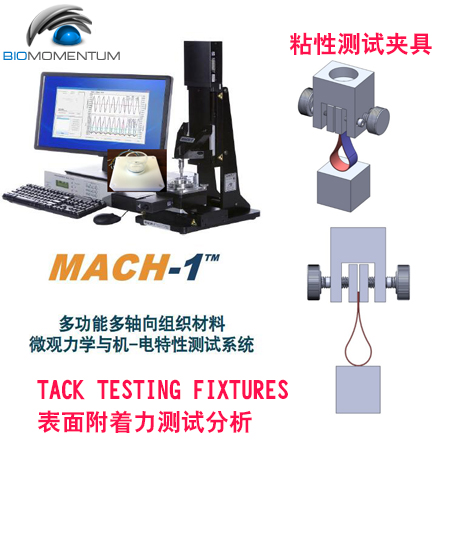细胞-材料相互作用力测试分析仪,细胞材料黏附脱落测试评估系统,细胞与材料间粘合力测试分析系统,细胞黏附材料测试仪,细胞与材料间黏附力检测分析系统
型号:BMM MachOne
联系人:李先生
联系电话:18618101725
品牌:BMM

1、培养液浸没式粘附黏合力测试分析
2、支持wu损伤倒置探针和倒置探针(ASTM D2979)或环形(ASTM D6195)粘性测试
These tack testing fixtures can be used to measure the tack properties (instantaneous adhesion) of adhesives either through the inverted probe (ASTM D2979) or the loop (ASTM D6195) tack testing methods. It comprises: for the inverted probe technique (a flat indenter with a 5-mm diameter and annular loading weights) and for the loop (a tensile grip and a 1 inch flat base). The force required to completely peel out the material provides its tackiness.
Cell attachment or, lack of it, to biomaterials is a critical factor affecting the performance of a device or implant. Cell attachment is a complicated, time-dependent, process involving significant morphological changes of the cell and deposition of a bed of extracellular matrix. Details of the adhesive bond that is formed have been reviewed by, for example, Pierres et al (2002) (4), Lukas and Dvorak (2004) (5), and Garcia and Gallant (2003) (6). The strength of this coupling can be determined either by monitoring the force of attachment between a cell and a substrate over time or by measuring the force required to detach the cell once it has adhered.
Cell adhesion to a surface depends on a range of biological and physical factors that include the culture history, the age of the cell, the cell type, and both the chemistry and morphology of the underlying surface and time. These elements that need to be considered in developing a test protocol.
Devising robust methods for measuring the propensity of cells to attach to different substrates is further complicated since either cell adhesion or detachment can be assessed. These processes that are not always similar or complementary.
Most studies of cell attachment focus on obtaining some measure of the time-dependent force required to detach, or de-adhere, cells that have already adhered to a surface (James et al, 2005) (7). More recently investigators have begun to measure the adhesive forces that develop between cells and the underlying surface during attachment (Lukas and Dvorak, 2004) (5). From a practical point of view, it is much easier to measure the force required to detach or de-adhere cells from a surface than to measure those that develop during attachment. However, in both cases, the experimental data should be interpreted with a degree of caution that depends on the intended use of the measurements. The methods of measuring cell adhesion described herein are measures of the force required to detach an adherent cell.
The purpose of this guide is to provide an overview of current generic test methods and identify the key factors that influence the assessment of cell adhesion and detachment. It is anticipated that this guide will form the basis for producing a series of standards that will describe these test methods in more detail.
Scope
1.1 This guide describes protocols that can be used to measure the strength of the adhesive bond that develops between a cell and a surface as well as the force required to detach cells that have adhered to a substrate. Controlling the interactions of mammalian cells with surfaces is fundamental to the development of safe and effective medical products. This guide does not cover methods for characterizing surfaces. The information generated by these methods can be used to obtain quantitative measures of the susceptibility of surfaces to cell attachment as well as measures of the adhesion of cells to a surface. This guide also highlights the importance of cell culture history and influences of cell type.
1.2 This standard does not purport to address all of the safety concerns, if any, associated with its use. It is the responsibility of the user of this standard to establish appropriate safety and health practices and determine the applicability of regulatory limitations prior to use.